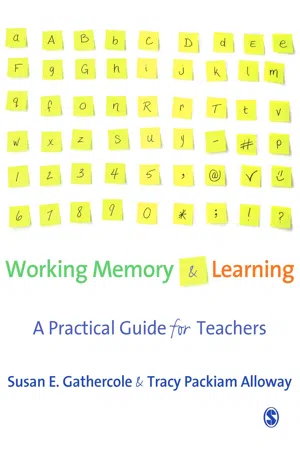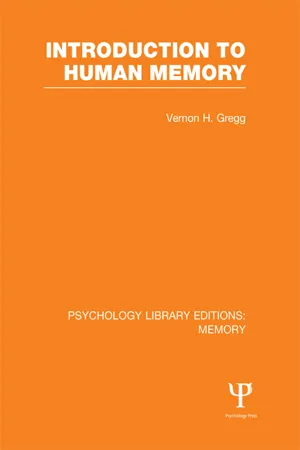Developmental Pattern of Digit Span
The developmental pattern of digit span refers to the typical progression of an individual's ability to remember and repeat sequences of numbers. Research has shown that digit span tends to increase with age, reflecting improvements in working memory and cognitive processing. This developmental pattern is often used as a measure of cognitive development and can vary across individuals.
4 Key excerpts on "Developmental Pattern of Digit Span"
- eBook - ePub
Working Memory and Learning
A Practical Guide for Teachers
- Susan Gathercole, Tracy Packiam Alloway(Authors)
- 2008(Publication Date)
- SAGE Publications Ltd(Publisher)
...In these tests, the first lists that are presented consist only of two items, and then are gradually increased in length until errors are made, at which point testing is stopped. The length at which an individual can remember a sequence at about 50% accuracy is known as memory span, and reflects his or her personal memory limits on a particular task. On average, forward digit span for an adult is around seven items, and backward digit span is either four or five. Forward digit span provides a measure of verbal short-term memory: it only requires the rememberer to store and faithfully reproduce the material, without the need to mentally transform it. Backward digit recall, on the other hand, involves not only remembering but also reversing the sequence in which the numbers were presented, which is a challenging mental activity. Because this task combines short-term memory and other significant mental processing, backward digit span draws upon both verbal short-term memory and the central executive components of working memory. As such, it therefore provides a measure of working memory rather than of short-term memory. The capacity of working memory increases across the childhood years. This is illustrated in Figure 2.1 which shows the performance of typical children aged from 5 to 15 years on tests of the three main aspects of working memory: verbal short-term memory, visuo-spatial short-term memory, and working memory (which involves the central executive and at least one of the short-term memory components). The scale of the graph is not important: a score of 100 on the y axis simply corresponds to average performance across all groups from ages 4 to 15. The growth functions are very similar for all three aspects of working memory, with marked working memory capacity between 5 and 11 years of age, followed by small but significant increases up to 15 years when adult levels are reached...
- Charles Hulme, Susie Mackenzie(Authors)
- 2014(Publication Date)
- Psychology Press(Publisher)
...Digit span is included in such tests because there is a gradual, steady increase in performance on the test from the age of 4 to 5 years to around 16 years. At age 4 the individual can recall on average just 3 digits in order, but performance normally improves steadily to about 6 digits at age 10 or 12; then there is a more gentle increase up to age 16 when digit span plateaus at around 7 to 8 items. When the Wechsler Intelligence Scale for Children was revised in 1976 the digit span sub-test was found to correlate moderately with the full-score IQ based on 10 sub-tests (r = 0.43). Not surprisingly, the correlation of digit span with the other five language sub-tests (r = 0.45) was higher than with the six performance tests (r = 0.34). These figures are based on the performance of 1,100 normal children aged 6 to 16 used in the standardization and revision of the WISC (Wechsler, 1976). Bachelder and Denny (1977) reviewed a number of studies in which a wider IQ range was included (normal children and those with learning difficulties). They found that when a broader IQ range is sampled, the correlation coefficient between digit span and other IQ sub-tests increases to figures in the 0.6 to 0.8 range. Just as the increase in memory span is a consistent feature of normal development, so it has often been noted that memory span is impaired in groups with learning difficulties. In the 1880s, Galton measured memory span in “feeble-minded” individuals (i.e. those with learning difficulties), and found that although span varied amongst those classed as feeble-minded, their memory span was lower than that of normal individuals...
- eBook - ePub
- Vernon Gregg(Author)
- 2014(Publication Date)
- Psychology Press(Publisher)
...9 Development of memory The scientific study of children’s memory goes back to the early days of experimental psychology. Early investigations include those of Hunter (1917) who found that young children, having seen an object hidden in a particular location, would seek it out with declining success as the retention interval was increased. Kirkpatrick (1894) reported changes in free recall performance with age, and Jacobs (1887) investigated developmental changes in digit span (this increases steadily from about 4 digits at 4 to 5 years, through 5 digits at 6 to 8 years to 6 at 9 to 12 years, and about 7 at 13 years onwards). The close relationship between the development of memory and other cognitive processes was acknowledged by the inclusion of episodic memory items in tests of children’s intelligence. The Stanford Binet test (Terman, 1916), for example, included tests of span together with other items such as placing an object under a box and asking the child to recognize an identical object from amongst a number of distractors. On the whole, it seems that early concern centred on the use of memory tests for diagnostic purposes rather than on understanding the changes which take place in memory. This emphasis has gradually changed and in recent years the number of experimental investigations concerned with the development of memory has been increasing rapidly. As with the study of adult memory, various theoretical approaches have been adopted in order to understand memory development in children. Some theorists, such as Piaget and the Geneva school of developmentalists, have been concerned with the growth of cognitive processes and knowledge in general. Their interest in episodic memory has been subservient to these aims. Others, working within the tradition of information processing theory, have attempted a detailed analysis of the structures and strategies which change with growth...
- eBook - ePub
Human Development from Early Childhood to Early Adulthood
Findings from a 20 Year Longitudinal Study
- Wolfgang Schneider, Merry Bullock(Authors)
- 2010(Publication Date)
- Psychology Press(Publisher)
...Beginning with the smallest set of three words, children were given two trials for each set size. They were instructed to listen to the entire set and then to repeat the words they heard. Whenever an item set could be correctly reproduced, the next set including n + 1 items was presented. This procedure continued until the children could no longer recall all of the items. Two different dependent measures were calculated. The first word span measure was identical to that used by Case et al. Participants were given credit for correctly recalling a set of items as long as they could remember all of the words, regardless of order (i.e., unconstrained word span). According to Case and colleagues, this measure ensures that developmental differences in span are not confounded with differences in encoding and preserving information about order. A second measure was the serial word span (words had to be recalled in the correct order), which enabled us to explore differences in these two span measures as a function of age. efficient phonetic coding in working memory seems important for various memory purposes, and it may play a particularly crucial role for beginning readers because it frees the maximum amount of cognitive resources for the difficult task of blending sounds together to form words (see Wagner & Torgesen, 1987). The use of memory span tasks with items such as letters, numbers, words, or sentences to tap efficient processing of information is based on the theoretical assumption that working memory has storage and processing functions that compete for a shared, limited capacity (see Baddeley, 1986; Case et al., 1982). 4.3.1.1.1 Sentence Span The main reason to include a sentence span (listening span) memory measure was to explore the impact of working memory on the development of reading and spelling. Thus, we adopted the Daneman and Blennerhassett (1984) listening span measure and first used it in Wave 3, when children were in their last kindergarten year...



